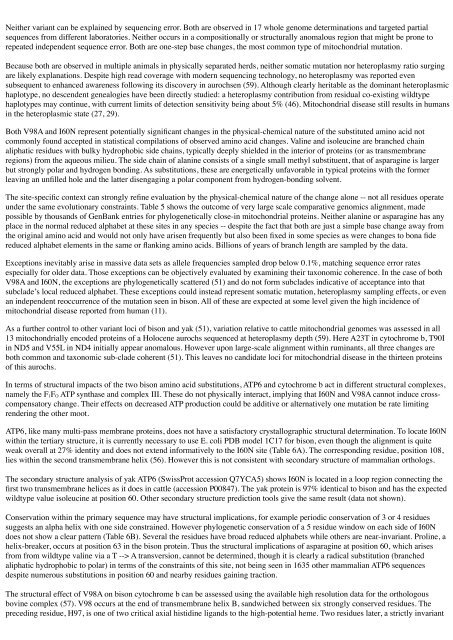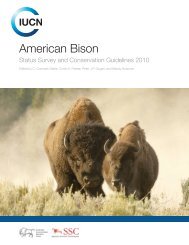Declaration Dr. Thomas H. Pringle - Buffalo Field Campaign
Declaration Dr. Thomas H. Pringle - Buffalo Field Campaign
Declaration Dr. Thomas H. Pringle - Buffalo Field Campaign
Create successful ePaper yourself
Turn your PDF publications into a flip-book with our unique Google optimized e-Paper software.
Neither variant can be explained by sequencing error. Both are observed in 17 whole genome determinations and targeted partial<br />
sequences from different laboratories. Neither occurs in a compositionally or structurally anomalous region that might be prone to<br />
repeated independent sequence error. Both are one-step base changes, the most common type of mitochondrial mutation.<br />
Because both are observed in multiple animals in physically separated herds, neither somatic mutation nor heteroplasmy ratio surging<br />
are likely explanations. Despite high read coverage with modern sequencing technology, no heteroplasmy was reported even<br />
subsequent to enhanced awareness following its discovery in aurochsen (59). Although clearly heritable as the dominant heteroplasmic<br />
haplotype, no descendent genealogies have been directly studied: a heteroplasmy contribution from residual co-existing wildtype<br />
haplotypes may continue, with current limits of detection sensitivity being about 5% (46). Mitochondrial disease still results in humans<br />
in the heteroplasmic state (27, 29).<br />
Both V98A and I60N represent potentially significant changes in the physical-chemical nature of the substituted amino acid not<br />
commonly found accepted in statistical compilations of observed amino acid changes. Valine and isoleucine are branched chain<br />
aliphatic residues with bulky hydrophobic side chains, typically deeply shielded in the interior of proteins (or as transmembrane<br />
regions) from the aqueous milieu. The side chain of alanine consists of a single small methyl substituent, that of asparagine is larger<br />
but strongly polar and hydrogen bonding. As substitutions, these are energetically unfavorable in typical proteins with the former<br />
leaving an unfilled hole and the latter disengaging a polar component from hydrogen-bonding solvent.<br />
The site-specific context can strongly refine evaluation by the physical-chemical nature of the change alone -- not all residues operate<br />
under the same evolutionary constraints. Table 5 shows the outcome of very large scale comparative genomics alignment, made<br />
possible by thousands of GenBank entries for phylogenetically close-in mitochondrial proteins. Neither alanine or asparagine has any<br />
place in the normal reduced alphabet at these sites in any species -- despite the fact that both are just a simple base change away from<br />
the original amino acid and would not only have arisen frequently but also been fixed in some species as were changes to bona fide<br />
reduced alphabet elements in the same or flanking amino acids. Billions of years of branch length are sampled by the data.<br />
Exceptions inevitably arise in massive data sets as allele frequencies sampled drop below 0.1%, matching sequence error rates<br />
especially for older data. Those exceptions can be objectively evaluated by examining their taxonomic coherence. In the case of both<br />
V98A and I60N, the exceptions are phylogenetically scattered (51) and do not form subclades indicative of acceptance into that<br />
subclade’s local reduced alphabet. These exceptions could instead represent somatic mutation, heteroplasmy sampling effects, or even<br />
an independent reoccurrence of the mutation seen in bison. All of these are expected at some level given the high incidence of<br />
mitochondrial disease reported from human (11).<br />
As a further control to other variant loci of bison and yak (51), variation relative to cattle mitochondrial genomes was assessed in all<br />
13 mitochondrially encoded proteins of a Holocene aurochs sequenced at heteroplasmy depth (59). Here A23T in cytochrome b, T90I<br />
in ND5 and V55L in ND4 initially appear anomalous. However upon large-scale alignment within ruminants, all three changes are<br />
both common and taxonomic sub-clade coherent (51). This leaves no candidate loci for mitochondrial disease in the thirteen proteins<br />
of this aurochs.<br />
In terms of structural impacts of the two bison amino acid substitutions, ATP6 and cytochrome b act in different structural complexes,<br />
namely the F1FO ATP synthase and complex III. These do not physically interact, implying that I60N and V98A cannot induce crosscompensatory<br />
change. Their effects on decreased ATP production could be additive or alternatively one mutation be rate limiting<br />
rendering the other moot.<br />
ATP6, like many multi-pass membrane proteins, does not have a satisfactory crystallographic structural determination. To locate I60N<br />
within the tertiary structure, it is currently necessary to use E. coli PDB model 1C17 for bison, even though the alignment is quite<br />
weak overall at 27% identity and does not extend informatively to the I60N site (Table 6A). The corresponding residue, position 108,<br />
lies within the second transmembrane helix (56). However this is not consistent with secondary structure of mammalian orthologs.<br />
The secondary structure analysis of yak ATP6 (SwissProt accession Q7YCA5) shows I60N is located in a loop region connecting the<br />
first two transmembrane helices as it does in cattle (accession P00847). The yak protein is 97% identical to bison and has the expected<br />
wildtype value isoleucine at position 60. Other secondary structure prediction tools give the same result (data not shown).<br />
Conservation within the primary sequence may have structural implications, for example periodic conservation of 3 or 4 residues<br />
suggests an alpha helix with one side constrained. However phylogenetic conservation of a 5 residue window on each side of I60N<br />
does not show a clear pattern (Table 6B). Several the residues have broad reduced alphabets while others are near-invariant. Proline, a<br />
helix-breaker, occurs at position 63 in the bison protein. Thus the structural implications of asparagine at position 60, which arises<br />
from from wildtype valine via a T --> A transversion, cannot be determined, though it is clearly a radical substitution (branched<br />
aliphatic hydrophobic to polar) in terms of the constraints of this site, not being seen in 1635 other mammalian ATP6 sequences<br />
despite numerous substitutions in position 60 and nearby residues gaining traction.<br />
The structural effect of V98A on bison cytochrome b can be assessed using the available high resolution data for the orthologous<br />
bovine complex (57). V98 occurs at the end of transmembrane helix B, sandwiched between six strongly conserved residues. The<br />
preceding residue, H97, is one of two critical axial histidine ligands to the high-potential heme. Two residues later, a strictly invariant










